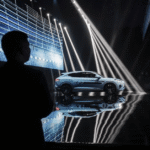Meta has made waves in the technology landscape with the introduction of its latest innovation, the Orion glasses. These smart glasses represent a significant stride in the realm of augmented reality (AR), positioning themselves as a potential rival to smartphones. With the promise of blending the physical and digital worlds seamlessly, Orion aims to transform how users interact with their environment and each other. This article delves into the features, implications, and future of the Orion glasses, exploring their potential to redefine personal and social interactions in an increasingly digital world.
The Vision Behind Orion
Mark Zuckerberg, the CEO of Meta, has long envisioned a future where augmented reality plays a central role in daily life. He has articulated a goal to create a new computing platform that transcends traditional devices, delivering a deeper sense of presence and connectivity. In his words, “With Orion, we are getting closer to achieving the dream… to create the next major computing platform that delivers a deep sense of presence, like you were right there with another person.”
Zuckerberg’s vision for Orion is not just about enhancing personal technology; it’s about redefining social interaction in a world increasingly reliant on digital communication. By overlaying digital content onto the physical world, Orion aims to facilitate more meaningful connections among users, regardless of their physical proximity.
Advanced Features and Functionality
The Orion glasses come packed with advanced features that leverage artificial intelligence to enhance user experience. Here are some of the standout functionalities:
1. AI-Enhanced Interactions
Orion is equipped with sophisticated AI capabilities, allowing it to recognize objects and provide contextual information. For instance, users can ask questions about what they see, and the glasses can respond with relevant data. This feature transforms the glasses into a dynamic information tool, where users can learn about their surroundings in real time.
2. Real-Time Translation
One of the most compelling features of Orion is its ability to facilitate real-time translation. In an increasingly globalized world, the ability to communicate across language barriers is invaluable. Users can engage in conversations with others who speak different languages, and Orion can translate spoken words on the fly. This not only enhances communication but also fosters a sense of connection among diverse individuals.
3. Augmented Reality Overlays
Perhaps the most groundbreaking aspect of Orion is its capability to overlay digital content onto the user’s view of the real world. This means that users can see holograms and other digital elements integrated seamlessly into their environment. Whether it’s a navigation prompt while walking, information about a landmark, or even a game element, the potential applications are vast and varied.
Design Considerations
Zuckerberg has emphasized that the design of Orion is crucial for its acceptance in the market. The goal is to create a product that is not only functional but also stylish and comfortable for everyday wear. Current prototypes weigh about 100 grams, making them heavier than standard eyewear but significantly lighter than full AR headsets like Meta Quest or Apple’s Vision Pro.
Streamlined Aesthetics
The design philosophy behind Orion leans heavily towards aesthetics and usability. Meta aims to ensure that the glasses look and feel like a regular pair of eyewear rather than bulky tech gadgets. This emphasis on style is critical, as it targets consumers who may be hesitant to adopt technology that disrupts their daily lives.
Social Connectivity and Interaction
One of the most exciting features of Orion is its potential to enhance social connectivity. As more people engage with technology in social settings, the ability to share experiences through AR becomes increasingly valuable. Orion facilitates this by allowing users to interact with each other through digital experiences, regardless of their physical location.
Virtual Gaming and Shared Experiences
Zuckerberg has highlighted that users can engage in virtual games and activities while wearing Orion glasses. This capability encourages social interaction in new ways, allowing friends and family to connect over shared experiences. Imagine playing a game of chess where each player sees their pieces as holograms in the same physical space, despite being miles apart.
The ability to engage in such interactive experiences could redefine how we view social gaming and collaboration. This shift toward virtual connection can be particularly impactful in a post-pandemic world where physical gatherings are less frequent.
Gesture and Voice Control
To create a more intuitive user experience, Orion incorporates gesture recognition and voice control. Users can perform simple gestures, such as finger-tapping, to trigger various functions. This gesture-based interface allows for quick access to apps, games, and other features without needing to fumble with buttons or screens.
Eye Tracking Technology
In addition to gestures, Orion uses eye-tracking technology to enhance user interaction. This means users can navigate menus and select options simply by looking at them, streamlining the overall experience. Eye tracking offers a natural way to control digital content and reduces the learning curve associated with new technology.
Challenges and Considerations
While the potential for Orion is immense, there are several challenges that Meta will need to address as it moves toward commercializing these glasses.
1. Privacy Concerns
As with any device that collects data and interacts with the physical world, privacy concerns are paramount. Users may be apprehensive about the ability of the glasses to record conversations or recognize individuals without their consent. Meta must navigate these concerns carefully, ensuring that user data is handled securely and transparently.
2. Technological Limitations
Developing a product that seamlessly integrates AR into daily life is no small feat. The current prototypes are still in the testing phase, and there are technological hurdles that need to be overcome. Ensuring that the glasses can function effectively in various lighting conditions, for instance, is crucial for usability.
3. Market Competition
Orion is entering a competitive landscape, with tech giants like Apple and Google also investing heavily in AR and wearable technology. Meta will need to differentiate Orion not just through features but also through user experience and brand positioning. Building a loyal customer base will require significant marketing and education about the glasses’ capabilities.
The Future of Augmented Reality
The launch of Orion marks an important milestone in the journey toward widespread augmented reality adoption. As technology continues to evolve, the potential applications of AR will only grow. Here are some potential future directions for the Orion glasses and AR technology as a whole:
1. Enhanced Education and Training
Orion’s capabilities could revolutionize education and training by providing immersive learning experiences. Imagine students learning about anatomy through interactive holograms or trainees in a field learning real-world skills with AR guidance. The educational applications for AR technology are vast, promising to enhance engagement and retention.
2. Health and Wellness Applications
The health and wellness sectors can benefit significantly from AR technology. Orion could be used in physical therapy, guiding patients through exercises with real-time feedback. Additionally, health professionals could use AR to visualize patient data or anatomical structures during procedures, enhancing accuracy and outcomes.
3. Retail and Consumer Experiences
In retail, AR glasses can transform the shopping experience. Consumers could see how furniture looks in their homes or try on clothes virtually. Orion could enable retailers to create engaging, interactive experiences that merge the physical and digital shopping realms, thereby enhancing consumer satisfaction.
4. Integration with Smart Cities
As cities become smarter and more connected, the role of AR in urban environments will likely expand. Orion could provide users with real-time information about their surroundings, such as navigation prompts, historical data about landmarks, or alerts about public transportation schedules. This integration could significantly enhance urban living.
The unveiling of Meta’s Orion glasses represents a bold step toward the future of augmented reality and personal technology. By combining advanced AI capabilities with stylish design and social connectivity, Orion has the potential to redefine how we interact with the world and each other.
As Meta continues to refine the glasses and address challenges related to privacy, technology, and market competition, the vision of a seamless blend of physical and digital realities draws closer. While the road ahead may be complex, the possibilities for Orion and AR technology are vast, promising to transform personal interactions, education, healthcare, and much more.
The journey toward a fully realized AR experience is just beginning, and the introduction of Orion may be the catalyst needed to propel this technology into the mainstream. As consumers become more comfortable with immersive experiences, the demand for innovative solutions like Orion will likely grow, paving the way for a new era of computing.
#MetaOrion #AugmentedReality #SmartGlasses #TechInnovation #FutureOfComputing







